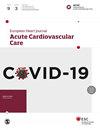主动脉瓣狭窄和心源性休克患者的经导管主动脉瓣置换术与外科主动脉瓣置换术的比较
IF 3.9
2区 医学
Q1 CARDIAC & CARDIOVASCULAR SYSTEMS
引用次数: 0
摘要
背景 主动脉瓣狭窄(AS)和心源性休克(CS)患者属于极高风险人群,在缺乏明确治疗的情况下预后较差。目的 比较经导管主动脉瓣置换术(TAVR)和手术主动脉瓣置换术(SAVR)对 AS-CS 患者的治疗效果。方法 我们查询了全国再入院数据库(2016-2021 年),以确定因 AS-CS 住院并接受单独 TAVR 或 SAVR 的患者。使用多变量回归和倾向匹配分析比较了 TAVR 与 SAVR 的院内预后。使用 Cox 比例危险度回归模型比较了 90 天再入院情况。结果 在16072名因AS-CS住院的患者中,6381人(39.7%)接受了单独的TAVR,9691人(60.3%)接受了单独的SAVR。从2016年到2021年,在AS-CS中,TAVR的比例从29.5%增加到46.5%,SAVR的比例相应减少(ptrend<0.01)。对基线特征进行调整后,与SAVR相比,TAVR与较低的卒中几率(调整几率比[aOR]0.59,95%置信区间[CI]0.44-0.79)、急性肾损伤(aOR 0.79,95% CI 0.68-0.92)和大出血(aOR 0.54,95% CI 0.40-0.72)相关,而与较高的血管并发症几率(aOR 1.55,95% CI 1.22-1.96)相关。院内死亡率、心肌梗死、永久起搏器置入、90 天全因再住院率和心衰再住院率相似。TAVR 的住院时间更短,总费用和非居家出院率更低。结论 这项全国性的观察分析表明,越来越多的 AS-CS 患者接受了 TAVR,与 SAVR 相比,TAVR 的院内死亡率和 90 天再入院率相似,但院内并发症和资源利用率较低。本文章由计算机程序翻译,如有差异,请以英文原文为准。
Transcatheter Versus Surgical Aortic Valve Replacement in Patients with Aortic Stenosis and Cardiogenic Shock
Background Patients with aortic stenosis (AS) and cardiogenic shock (CS) are an extremely high-risk population with a poor prognosis in the absence of definitive therapy. Aims To compare the outcomes of transcatheter aortic valve replacement (TAVR) with surgical AVR (SAVR) in patients with AS-CS. Methods We queried the Nationwide Readmission Database (2016-2021) to identify patients hospitalized for AS-CS who underwent isolated TAVR or SAVR. In-hospital outcomes of TAVR vs SAVR were compared using multivariable regression and propensity-matching analyses. Ninety-day readmissions were compared using Cox proportional hazards regression model. Results Of 16,072 patients hospitalized for AS-CS, 6,381 (39.7%) underwent isolated TAVR, and 9,691 (60.3%) underwent isolated SAVR. From 2016 through 2021, the proportion of TAVR increased from 29.5% to 46.5% and the proportion of SAVR correspondingly decreased in AS-CS (ptrend<0.01). After adjustment for baseline characteristics, TAVR was associated with lower odds of stroke (adjusted odds ratio [aOR] 0.59, 95% confidence interval [CI] 0.44-0.79), acute kidney injury (aOR 0.79, 95% CI 0.68-0.92), and major bleeding (aOR 0.54, 95% CI 0.40-0.72) and higher odds of vascular complications (aOR 1.55, 95% CI 1.22-1.96) compared with SAVR. In-hospital mortality, myocardial infarction, permanent pacemaker placement, and 90-day all-cause and heart failure readmissions were similar. Length of stay was shorter and total costs and nonhome discharges were lower with TAVR. Conclusions This nationwide observational analysis showed that TAVR is increasingly performed in patients with AS-CS and is associated with similar in-hospital mortality and 90-day readmissions, but lower in-hospital complications and resource utilization compared with SAVR.
求助全文
通过发布文献求助,成功后即可免费获取论文全文。
去求助
来源期刊

European Heart Journal: Acute Cardiovascular Care
Medicine-General Medicine
CiteScore
8.50
自引率
4.90%
发文量
325
期刊介绍:
The European Heart Journal - Acute Cardiovascular Care (EHJ-ACVC) offers a unique integrative approach by combining the expertise of the different sub specialties of cardiology, emergency and intensive care medicine in the management of patients with acute cardiovascular syndromes.
Reading through the journal, cardiologists and all other healthcare professionals can access continuous updates that may help them to improve the quality of care and the outcome for patients with acute cardiovascular diseases.
 求助内容:
求助内容: 应助结果提醒方式:
应助结果提醒方式:


